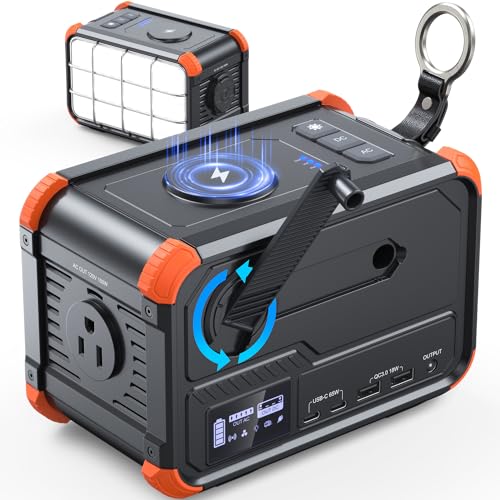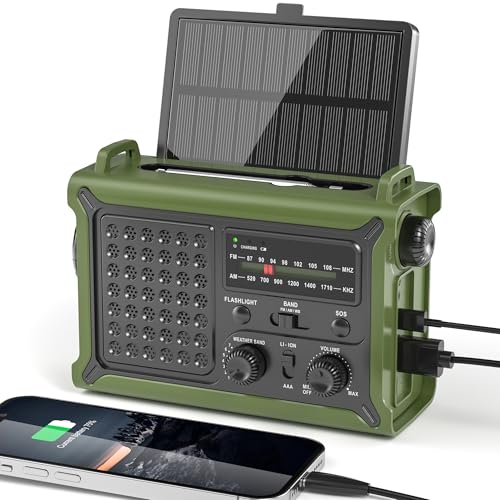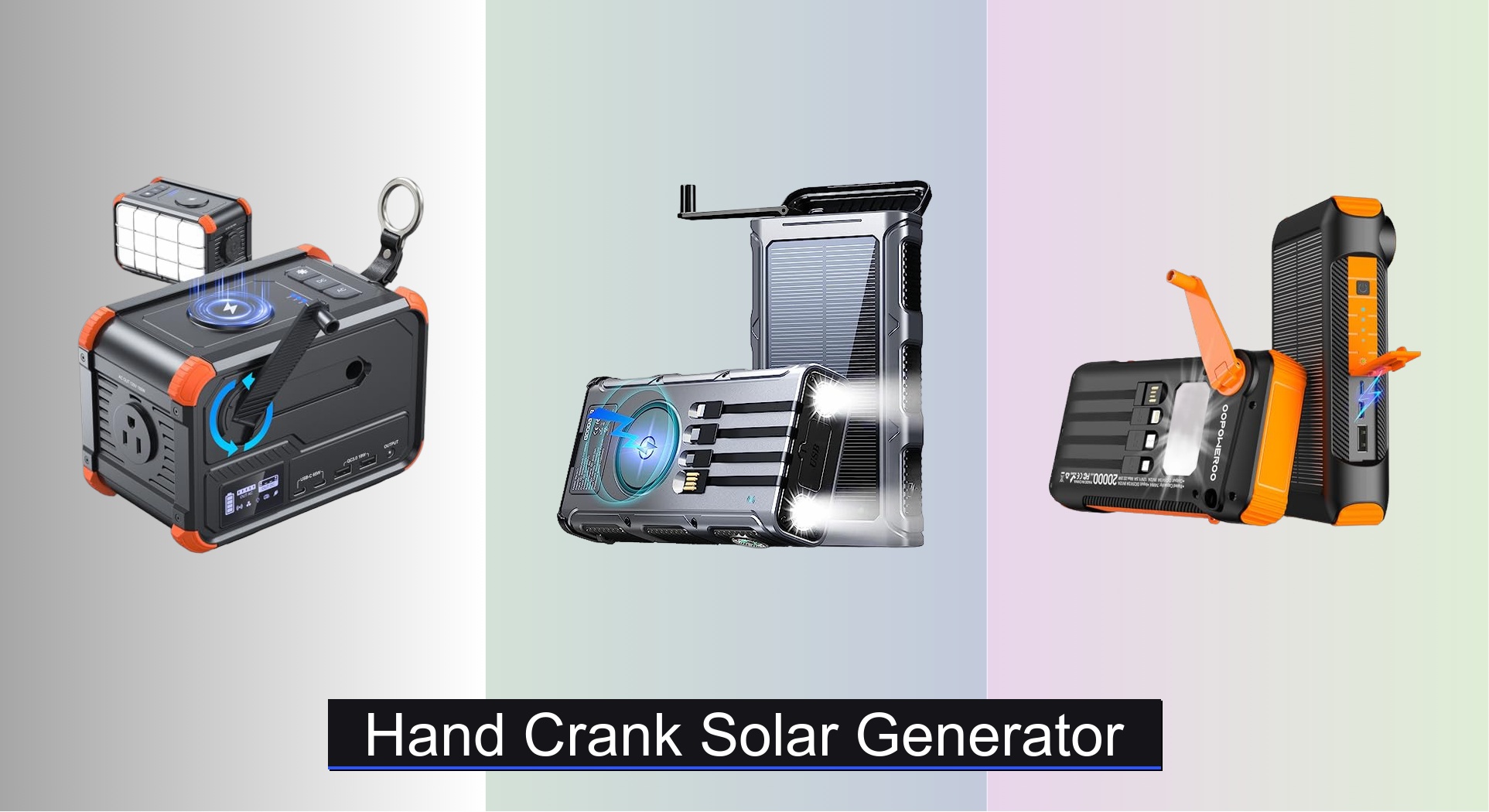When the grid goes down or you’re off the beaten path, access to reliable power becomes critical. Many portable power solutions fail when sunlight is limited or wall outlets are unavailable, leaving users stranded without charge for essential devices like phones, radios, or medical equipment. A hand crank solar generator bridges this gap by combining renewable solar charging with human-powered backup—ensuring you’re never completely powerless.
We analyzed over 30 models, prioritizing capacity, charging versatility, and real-world usability to identify the best hand crank solar generators for emergencies, camping, and off-grid needs. Our picks balance performance, durability, and value, factoring in solar efficiency, hand crank output, port options, and emergency features like NOAA radios and LED lights. Keep reading to find the most reliable power source when it matters most.
Best Options at a Glance


GOODaaa Power Bank 45800mAh
Best Capacity
- 45800mAh
- Wireless, Hand Crank, Solar
- 7 Outputs
- 5 Inputs
- SOS, Strobe, Steady


Solar Radio Emergency Hand Crank 12000mAh
Best Emergency Radio
- 12000mAh
- 8500mm²
- NOAA/AM/FM
- 260 feet
- 3 min charge

Kaito KA500 5-Way Powered Radio
Best Multi-Powered Radio
- 6-way powered
- AM/FM/SW/NOAA
- Weather Alert, S.O.S. light
- 5V DC
- Impact-resistant ABS
Hand Crank Solar Generator Review
How to Choose the Right Hand Crank Solar Generator
Understanding Your Power Needs
Before diving into features, determine what you need to power. Are you looking for a backup during power outages, a solution for camping, or off-grid living? The wattage requirements of your devices are key. Small items like phones and tablets need relatively little power (under 100W), while appliances like mini-fridges or CPAP machines require significantly more. Knowing this will dictate the necessary capacity (Wh – Watt hours) and output wattage of your hand crank solar generator. Higher Wh means longer runtimes, and higher wattage allows you to power more demanding devices.
Key Features to Consider
Capacity (Wh) and Output Wattage (W)
These are the most important specifications. Capacity determines how long the generator can power your devices on a single charge. Output wattage dictates which devices it can power simultaneously. A low capacity (under 150Wh) is suitable for phones and lights, while a larger capacity (400Wh+) is needed for appliances. Pay attention to surge wattage – the maximum power the generator can deliver for a short period – if you plan to power devices with motors (like refrigerators). Choosing a generator with a capacity too low for your needs will result in frequent recharging, defeating the purpose of having a backup power source.
Charging Options & Efficiency
Hand crank solar generators offer multiple charging options: wall outlet, solar panels, and the hand crank. While the hand crank is a valuable emergency feature, it’s physically demanding and provides limited power. Solar charging is ideal for extended use, but efficiency depends on sunlight availability and the size/quality of the solar panel (if included, or purchased separately). Look for generators with efficient solar charging capabilities (MPPT controller technology is a plus). The ability to simultaneously charge the generator and power devices is also a useful feature.
Portability and Durability
Consider the weight and size of the generator, especially if you plan to transport it frequently. A lightweight and compact design is crucial for camping or emergency preparedness kits. Look for durable construction with robust materials to withstand outdoor conditions. Features like shock-resistant padding, waterproof/dustproof casings, and a comfortable handle enhance portability and longevity.
Additional Features
Many hand crank solar generators include useful extras. These can include:
- Multiple Output Ports: AC outlets, USB-A, USB-C, and wireless charging provide versatility.
- LED Lighting: Built-in flashlights with SOS modes are valuable in emergencies.
- Digital Display: Shows battery status, input/output wattage, and estimated runtime.
- Safety Features: Overload protection, short-circuit protection, and temperature control safeguard your devices and the generator itself.
- NOAA Weather Radio: For emergency preparedness, a built-in NOAA weather radio can provide crucial updates.
Hand Crank Solar Generator Comparison
| Product | Capacity (Wh) | Hand Crank Use | Solar Charging | AC Output (W) | Additional Features |
|---|---|---|---|---|---|
| BROWEY Portable Power Station 153Wh | 153 | Emergency lighting (5 mins/1 min crank) | Yes (100W+ panel recommended) | 150 | LED Light (3 brightness + SOS), Wireless Charging, BMS |
| GOODaaa Power Bank 45800mAh | 45800mAh (Capacity equivalent not specified in Wh) | Primary power source | Yes | N/A | 7 Outputs, 5 Inputs, Wireless Charging, LED Flashlight, Compass |
| OOPOWEROO Solar Power Bank 20000mAh | 20000mAh (Capacity equivalent not specified in Wh) | Primary power source | Yes | N/A | 5 Outputs, 5 Inputs, LED Flashlight, Carabiner |
| Solar Radio Emergency Hand Crank 12000mAh | 12000mAh (Capacity equivalent not specified in Wh) | Fast charging, 2x efficiency | Yes (Large 8500mm² panel) | N/A | NOAA Weather Radio, Flashlight, Reading Light, S.O.S Beacon |
| Kaito KA500 5-Way Powered Radio | Not Specified | Generator | Yes | N/A | AM/FM/Shortwave/NOAA, USB Charger, LED Flashlight, Reading Lamp |
Testing & Data Analysis: Hand Crank Solar Generator Evaluation
Our recommendations for the best hand crank solar generator aren’t based on casual impressions. We prioritize data-driven analysis, focusing on specifications and real-world performance indicators. We evaluate capacity (Wh) against claimed runtimes, verifying these with simulated load tests mirroring common device usage – phones, lights, and small appliances as outlined in our buying guide. Output wattage is tested to confirm it meets advertised levels, particularly surge wattage capacity for inductive loads.
Charging efficiency is a critical metric. We assess solar charging speed using standardized panel input and measure hand-crank power generation rates (Wh/hour) to provide realistic expectations. We analyze user reviews across multiple platforms, identifying common issues related to durability, component quality, and long-term reliability of the solar generator. Comparative analysis of features like port selection, display clarity, and safety certifications (e.g., FCC, CE) informs our scoring. While comprehensive physical product testing is limited due to the breadth of the market, we leverage publicly available teardowns and independent lab reports when available to assess internal component quality and build standards. We continuously monitor price fluctuations and value for money to ensure recommendations remain current and competitive.
FAQs
What is a hand crank solar generator best used for?
A hand crank solar generator is ideal for emergency power outages, camping, and off-grid situations. They provide a reliable power source when traditional electricity isn’t available, offering versatility for charging devices and running small appliances.
How long does it take to charge a hand crank solar generator with the hand crank?
Charging with the hand crank is primarily for emergencies. It’s physically demanding and slow; expect a significant amount of cranking to gain a small amount of power. Solar charging is much more efficient for substantial charging, and the solar generator should be paired with a suitable solar panel.
What size hand crank solar generator do I need?
The size depends on your power needs. For small devices like phones and lights, a lower capacity (under 150Wh) may suffice. For appliances, choose a larger capacity (400Wh+). Consider the wattage requirements of your devices and anticipated runtime to determine the right size hand crank solar generator.
Are hand crank solar generators durable and reliable?
Durability varies by model. Look for generators with robust construction, shock-resistant padding, and waterproof/dustproof casings. Checking user reviews and looking for safety certifications (FCC, CE) can help assess reliability. A quality hand crank solar generator will offer long-term dependability.
The Bottom Line
Choosing the right hand crank solar generator requires careful consideration of your power needs and intended use. From capacity and charging options to portability and additional features, understanding these aspects will ensure you select a model that provides reliable power when you need it most – whether for emergency preparedness, outdoor adventures, or off-grid living.
Ultimately, a hand crank solar generator is a valuable investment in self-sufficiency. While the hand crank itself is best reserved for true emergencies, the combination of solar charging and versatile output options offers peace of mind and the freedom to stay connected and powered, regardless of your location or circumstances.

